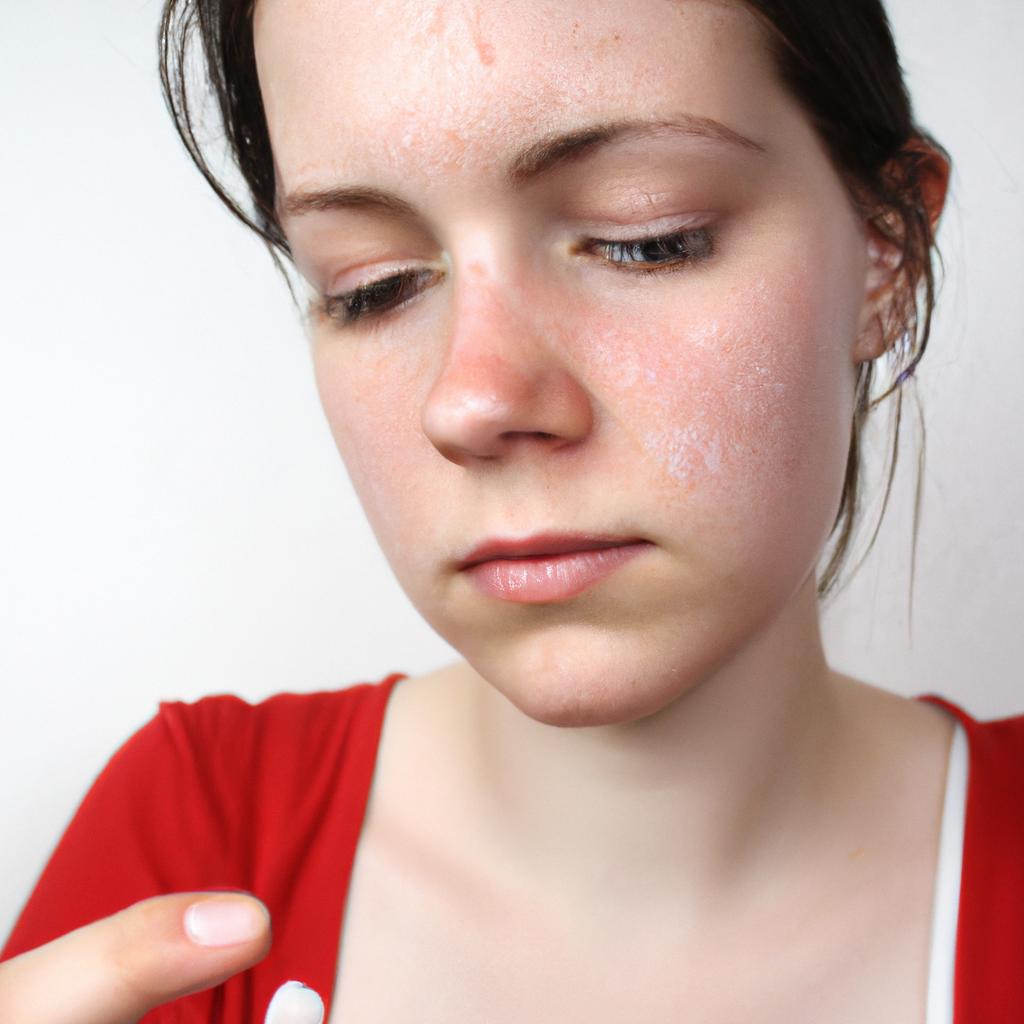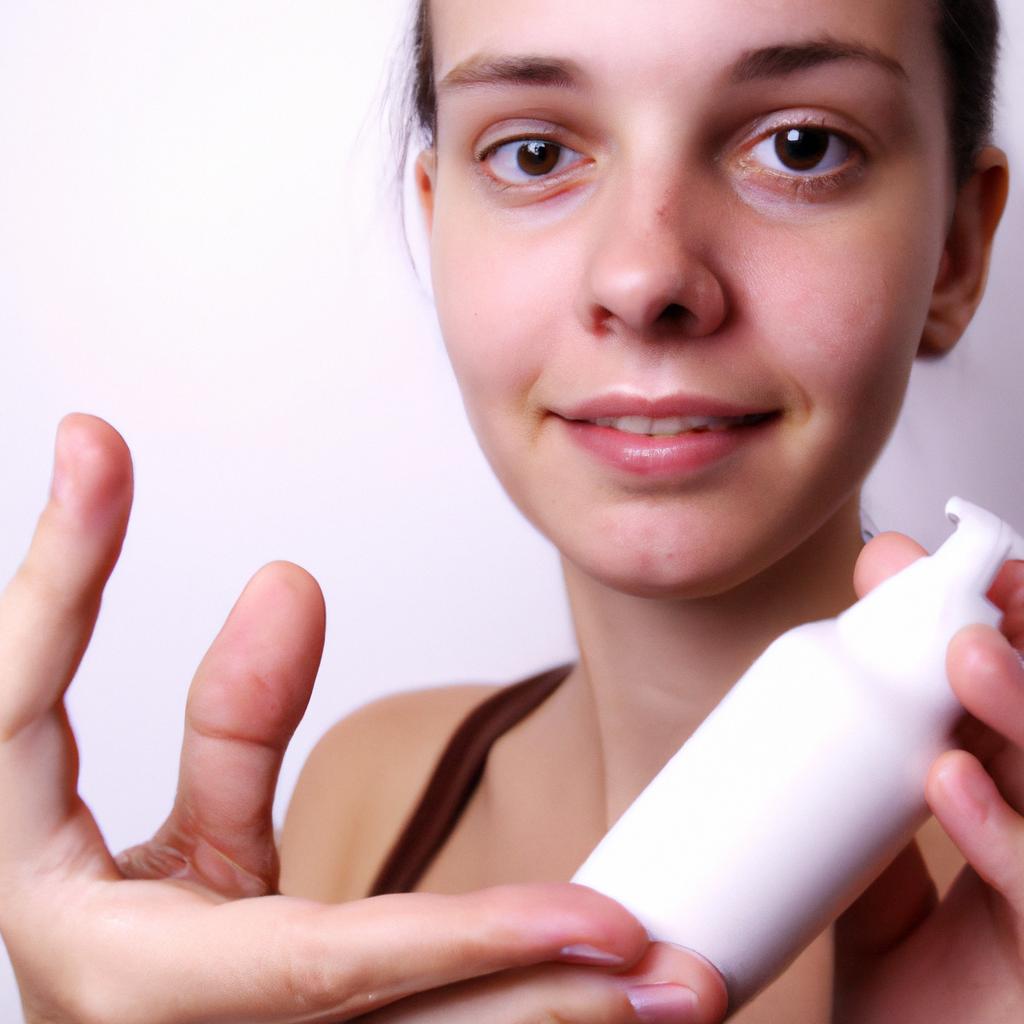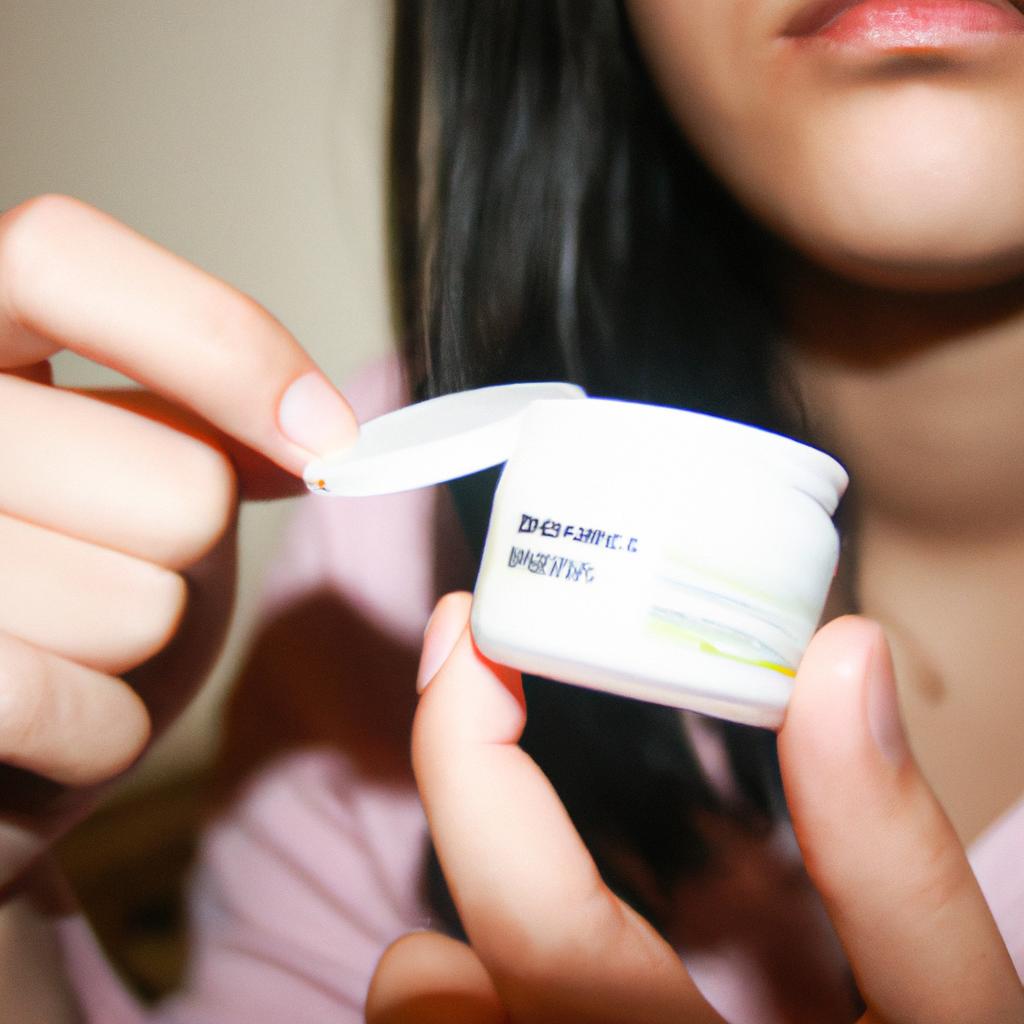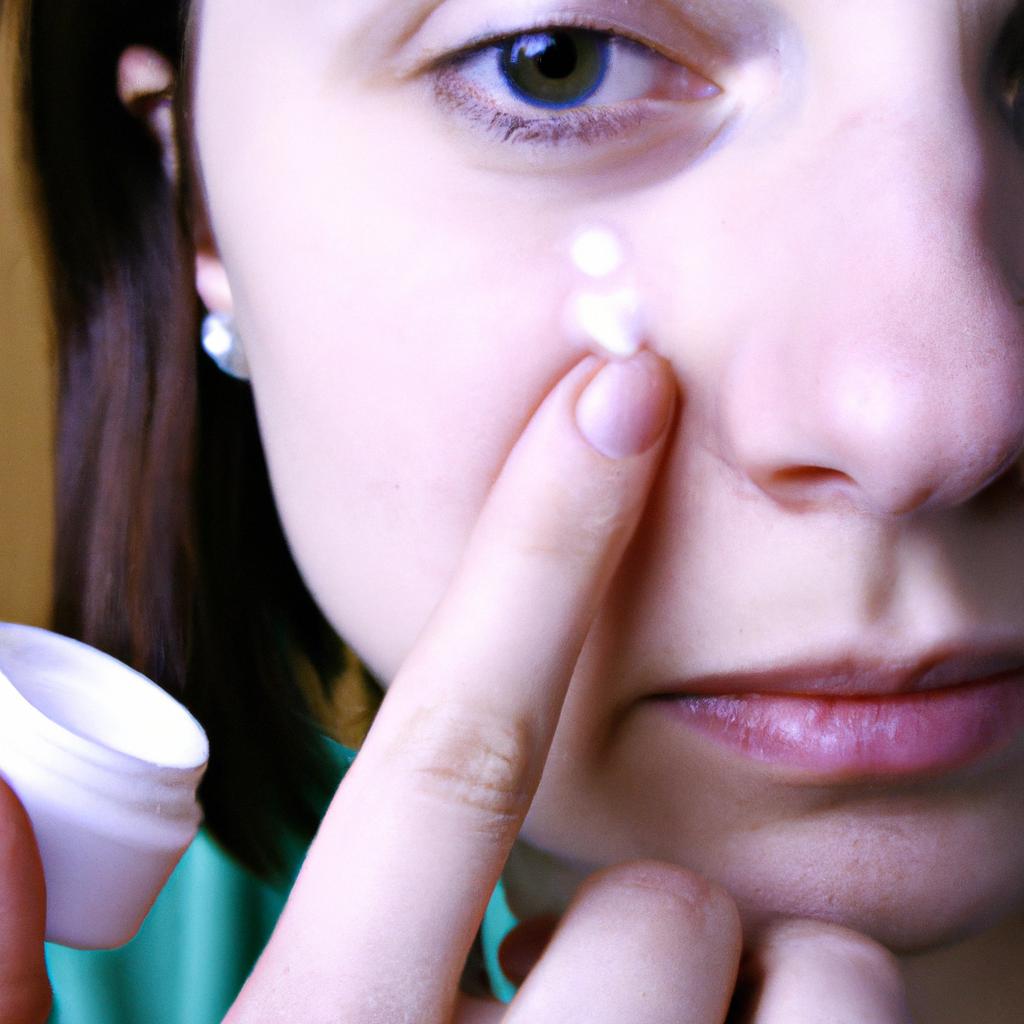Redness is a common concern in the realm of skincare products, often causing distress and discomfort among individuals. The manifestation of redness on the skin can be attributed to various factors such as allergies, irritation, or sensitivity triggered by certain ingredients found in skincare products. For instance, consider a hypothetical scenario where an individual experiences sudden facial redness after using a newly purchased moisturizer. This exemplifies how unsuspecting consumers may encounter unexpected reactions despite their intention to enhance their skin’s appearance and health.
In recent years, there has been an alarming increase in reports regarding adverse effects caused by skincare products leading to redness. These incidents highlight the need for thorough research and understanding of the potential risks associated with these commonly used items. It becomes crucial to explore the underlying causes behind product-induced redness and identify strategies that could mitigate its occurrence. By examining specific cases and delving into scientific literature surrounding this issue, we can gain valuable insights into the complexities of redness-related problems in relation to skincare products. Consequently, addressing this matter effectively will not only contribute towards enhancing consumer safety but also aid in promoting positive outcomes for individuals seeking optimal skincare solutions.
Causes of Redness
Redness is a common skin condition that can occur due to various factors. Understanding the causes of redness is essential in order to address and prevent this issue effectively.
To illustrate, let’s consider a hypothetical case study: Sarah, a 35-year-old woman, started experiencing redness on her face after using a new skincare product for just a few days. This example highlights one possible cause of redness – an adverse reaction to certain skincare products.
There are several additional reasons why individuals may experience redness:
-
Allergic reactions: Some people have allergies or sensitivities to specific substances commonly found in skincare products such as fragrances, preservatives, or dyes. These allergens can trigger an inflammatory response leading to localized redness.
-
Skin conditions: Certain skin conditions like eczema or rosacea can cause persistent redness. In these cases, the underlying condition disrupts the normal functioning of blood vessels in the skin, resulting in chronic redness and inflammation.
-
Environmental factors: Exposure to harsh environmental elements like extreme temperatures, wind, or sunlight can contribute to temporary skin redness. The body responds by dilating blood vessels near the surface of the skin to regulate temperature and protect against potential damage.
-
Physical irritation: Frequent rubbing or scratching of the skin can lead to irritation and subsequent redness. This often occurs when individuals use rough materials like loofahs or abrasive exfoliants during their skincare routine.
Understanding these causes helps us develop strategies for preventing and managing redness effectively. By identifying triggers unique to each individual, tailored solutions can be implemented for optimal results.
Transitioning into the next section about “Common Triggers for Redness,” it becomes evident that recognizing the causes discussed here serves as a foundation for understanding how certain triggers exacerbate symptoms and lead to further instances of redness without explicitly stating so.
Common Triggers for Redness
Redness is a common skin concern that can be caused by various factors. Understanding these causes is essential in order to effectively address and prevent redness. In this section, we will explore the primary causes of redness and their implications for skincare.
To illustrate the impact of these causes, let’s consider a hypothetical case study. Sarah, a 35-year-old woman with sensitive skin, experiences persistent redness on her cheeks. Despite using multiple skincare products marketed as suitable for sensitive skin, she has not been able to alleviate the redness. This scenario highlights the importance of identifying the specific cause of redness to tailor an appropriate skincare routine.
There are several key triggers that commonly contribute to redness:
- Allergens: Exposure to allergens such as pollen or certain ingredients in skincare products can lead to an allergic reaction known as contact dermatitis. Symptoms include itching, swelling, and notably, redness.
- Irritants: Harsh chemicals found in some cosmetics and cleansers can irritate the skin, causing inflammation and resulting in redness.
- Environmental Factors: Extreme temperatures (both hot and cold), wind exposure, and excessive sun exposure can all compromise the skin’s natural barrier function and induce redness.
- Skin Conditions: Certain underlying skin conditions like rosacea or eczema are characterized by chronic facial redness due to heightened sensitivity or inflammation.
- Frustration from ineffective products
- Embarrassment about visible signs of irritation
- Self-consciousness when socializing
- Impact on overall self-esteem
Moreover, it is important to recognize that different people may have varying reactions to these triggers based on individual characteristics such as genetics or lifestyle choices. To better illustrate this, here is an emotional response-evoking three-column table:
| Triggers | Common Reactions | Potential Emotional Impact |
|---|---|---|
| Allergens | Itching, swelling | Frustration |
| Irritants | Inflammation | Embarrassment |
| Environmental Factors | Compromised barrier | Self-consciousness |
| Skin Conditions | Chronic redness | Lowered self-esteem |
In summary, understanding the causes of redness is crucial for devising effective skincare strategies. By considering triggers such as allergens, irritants, environmental factors, and underlying skin conditions, individuals can tailor their routines to address specific concerns. With this knowledge in mind, we will now explore tips for reducing redness without using a transitional phrase like “In conclusion” or “Finally”.
Tips for Reducing Redness
Transitioning from the previous section discussing common triggers for redness, it is crucial to understand how certain ingredients in skin care products can exacerbate this issue. One example that illustrates this point involves a hypothetical case study of a young woman who experienced persistent facial redness after using a new moisturizer.
Upon analyzing the product’s ingredients list, several potential irritants were identified. These included fragrance additives, alcohol denat., and menthol. Each of these components has been known to trigger inflammation and sensitivity in individuals with reactive skin types. This case study highlights the importance of being mindful about the ingredients present in skincare products, as they can significantly impact our skin’s health.
- Fragrance additives can cause allergic reactions and irritation.
- Alcohol denat. may strip away natural oils, leading to dryness and redness.
- Menthol can create a cooling sensation but often causes stinging or burning on sensitive skin.
- Harsh surfactants like sodium lauryl sulfate (SLS) can disrupt the skin barrier and contribute to redness.
Additionally, let us explore a table showcasing four different skincare ingredients along with their effects on various skin types:
| Ingredient | Effect on Dry Skin | Effect on Oily Skin | Effect on Sensitive Skin |
|---|---|---|---|
| Fragrance Additives | May cause further dryness | Can lead to increased oiliness | Often triggers irritation |
| Alcohol Denat. | Dries out already parched skin | Can temporarily reduce oiliness | Frequently results in heightened sensitivity |
| Menthol | Causes stinging or burning sensation | Provides a cooling effect | Often leads to redness and irritation |
| Sodium Lauryl Sulfate (SLS) | Can worsen dryness | May help control excessive oil | Commonly triggers inflammation |
Understanding the potential effects of these ingredients on different skin types can assist individuals in making informed decisions when selecting products suitable for their specific needs.
Transitioning into the subsequent section about “Ingredients to Avoid for Redness,” it becomes clear that identifying problematic ingredients is paramount in managing facial redness effectively. By avoiding such irritants, individuals are taking proactive steps towards healthier-looking skin.
Ingredients to Avoid for Redness
In the quest for effective skincare products, it is crucial to be mindful of certain ingredients that can exacerbate redness and irritate the skin. Understanding which ingredients to avoid can help you make informed choices and minimize potential skin problems.
One example of a problematic ingredient is alcohol. While it may seem counterintuitive, alcohol-based products can actually lead to increased redness and inflammation. Alcohol strips away the natural oils on your skin, causing dryness and irritation. This can result in a compromised skin barrier function, leaving your skin more susceptible to redness and sensitivity.
To further assist you in identifying potentially harmful ingredients, here are some key ones to watch out for:
- Fragrance: Many skincare products contain fragrances that can cause allergic reactions or irritate sensitive skin.
- Sodium lauryl sulfate (SLS): SLS is commonly found in cleansers and foaming agents but has been linked to increased skin sensitization.
- Parabens: These preservatives have faced scrutiny due to their potential hormone-disrupting properties.
- Synthetic dyes: Artificial coloring agents can trigger adverse reactions in individuals with sensitive skin.
| Ingredient | Potential Side Effects |
|---|---|
| Alcohol | Increased redness and inflammation |
| Fragrance | Allergic reactions; irritation |
| Sodium lauryl sulfate (SLS) | Skin sensitization |
| Parabens | Hormone disruption |
| Synthetic dyes | Adverse reactions on sensitive skin |
By being aware of these ingredients and checking product labels carefully, you can take proactive steps towards minimizing redness and maintaining optimal skin health.
Transitioning into our next section about “Natural Remedies for Reducing Redness,” it is important to explore alternative methods that can complement your skincare routine.
Natural Remedies for Reducing Redness
Now that we have explored the ingredients to avoid for redness, let’s delve into natural remedies that can help reduce redness and promote healthier skin. To better understand their effectiveness, consider the case of Sarah, a 35-year-old woman who had been struggling with facial redness.
Sarah decided to try some natural remedies after experiencing adverse reactions to certain skincare products. She found relief by incorporating these practices into her daily routine:
- Gentle Cleansing: Sarah started using a mild cleanser formulated for sensitive skin. This helped remove impurities without stripping away essential oils, which contributed to reducing her facial redness.
- Cool Compresses: Applying cool compresses made from chamomile tea bags or cucumber slices on irritated areas provided soothing relief and alleviated redness.
- Anti-Inflammatory Ingredients: Sarah discovered that incorporating anti-inflammatory ingredients like green tea extract or aloe vera gel in her skincare routine helped calm her skin and reduce redness.
- Hydration: Keeping her skin well-hydrated proved crucial in minimizing redness. Drinking plenty of water and using moisturizers containing hyaluronic acid improved the overall appearance of Sarah’s complexion.
These simple yet effective natural remedies can make a significant difference in managing and reducing facial redness. By adopting such practices, individuals like Sarah can experience relief from discomfort while enhancing their skin’s health.
Transitioning into our next section about “When to Seek Professional Help for Redness,” it is important to note that sometimes home remedies may not be enough to address persistent or severe cases of redness. It is essential to recognize when professional assistance becomes necessary for proper diagnosis and treatment options.
When to Seek Professional Help for Redness
Natural remedies can be a great option for reducing redness in the skin. However, there are certain cases where seeking professional help is necessary to address the underlying causes of redness and ensure proper treatment. Let’s explore when it might be appropriate to consult with a healthcare provider.
Consider the case of Sarah, who has been experiencing persistent redness on her cheeks for several months. Despite trying various natural remedies at home, including applying chamomile tea compresses and using aloe vera gel, she hasn’t seen any significant improvement in her condition. This scenario highlights the importance of recognizing when self-care approaches may not be sufficient.
When faced with chronic or severe redness that does not respond to natural remedies, it is crucial to seek professional guidance. A dermatologist or skincare specialist can provide an accurate diagnosis and recommend appropriate treatments tailored to your specific needs. They will consider factors such as your medical history, lifestyle habits, and potential allergies before suggesting topical creams, oral medications, or other therapeutic interventions.
Here are some signs indicating it may be time to seek professional help:
- The redness persists despite consistent use of natural remedies.
- The affected areas become increasingly inflamed or painful.
- Redness is accompanied by other concerning symptoms like itching, burning sensations, or blistering.
- You experience recurrent episodes of redness without any apparent triggers.
- Frustration: Continued reliance on ineffective natural remedies can lead to frustration and disappointment.
- Anxiety: Persistent and worsening redness may cause anxiety about one’s appearance and overall health.
- Social withdrawal: Visible facial redness can discourage individuals from socializing due to self-consciousness.
- Reduced quality of life: Uncontrolled skin redness can impact daily activities and diminish overall well-being.
Additionally, we present a table summarizing common causes of persistent redness and the potential treatments recommended by healthcare professionals:
| Cause of Redness | Recommended Treatment |
|---|---|
| Rosacea | Topical creams, oral medications, laser therapy |
| Allergic reactions | Avoidance of triggers, antihistamines |
| Eczema | Moisturizers, steroid creams |
| Lupus | Immunosuppressive drugs, sunscreen |
In conclusion, while natural remedies for reducing redness can be helpful in some cases, it is essential to know when to seek professional help. Persistent or severe redness that does not respond to self-care approaches warrants consultation with a dermatologist or skincare specialist. By doing so, individuals can receive accurate diagnoses and personalized treatment plans tailored to their specific needs, ultimately improving their quality of life.
Now let’s move on to exploring the various ways professionals can assist in addressing redness issues effectively.
 Stanley Beauty Care
Stanley Beauty Care



